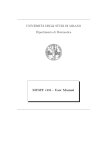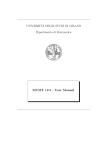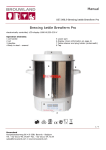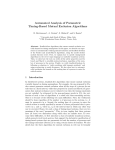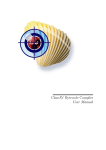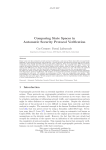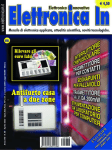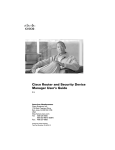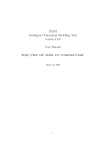Download MCMT v1.1.1 - User Manual (Draft)
Transcript
UNIVERSITA’ DEGLI STUDI DI MILANO
Dipartimento di Scienze dell’Informazione
MCMT v1.1.1 - User Manual
Silvio Ghilardi, Silvio Ranise
MCMT v1.1.1 - User Manual
Silvio Ghilardi1 and Silvio Ranise2
1
Dipartimento di Scienze dell’Informazione, Universit`a degli Studi di Milano (Italy)
2
Fondazione Bruno Kessler, Trento (Italy)
December 20, 2011
Abstract
This document is addressed to MCMT users: it explain from the beginning MCMT
input specifications and illustrate some common settings and heuristics. Advices for the
formalization of some useful classes of examples are also supplied.
This is a draft, subject to modifications and updates.
1
Contents
1 Introduction
3
2 Basic syntax
4
3
2.1
Types . . . . . . . . . . . . . . . . . . . . . . . . . . . . . . . . . . . . . . . .
4
2.2
Index variables . . . . . . . . . . . . . . . . . . . . . . . . . . . . . . . . . . .
4
2.3
Array variables . . . . . . . . . . . . . . . . . . . . . . . . . . . . . . . . . . .
5
MCMT specifications
7
3.1
Initialization . . . . . . . . . . . . . . . . . . . . . . . . . . . . . . . . . . . .
7
3.2
Unsafe states . . . . . . . . . . . . . . . . . . . . . . . . . . . . . . . . . . . .
8
3.3
Transitions . . . . . . . . . . . . . . . . . . . . . . . . . . . . . . . . . . . . .
9
3.4
Universal quantifiers in guards . . . . . . . . . . . . . . . . . . . . . . . . . .
13
3.5
System axioms . . . . . . . . . . . . . . . . . . . . . . . . . . . . . . . . . . .
14
4 Running MCMT
16
4.1
Parsing facilities . . . . . . . . . . . . . . . . . . . . . . . . . . . . . . . . . .
16
4.2
Options . . . . . . . . . . . . . . . . . . . . . . . . . . . . . . . . . . . . . . .
16
4.3
Invariant search options . . . . . . . . . . . . . . . . . . . . . . . . . . . . . .
18
4.4
Displayed information . . . . . . . . . . . . . . . . . . . . . . . . . . . . . . .
19
5 Advanced Settings
21
5.1
Interaction
. . . . . . . . . . . . . . . . . . . . . . . . . . . . . . . . . . . . .
21
5.2
Bounded Resources in Invariant Search . . . . . . . . . . . . . . . . . . . . . .
22
5.3
Signature Abstraction . . . . . . . . . . . . . . . . . . . . . . . . . . . . . . .
22
5.4
Quantifier elimination . . . . . . . . . . . . . . . . . . . . . . . . . . . . . . .
23
5.5
Acceleration . . . . . . . . . . . . . . . . . . . . . . . . . . . . . . . . . . . .
24
5.6
Cardinality bounds . . . . . . . . . . . . . . . . . . . . . . . . . . . . . . . . .
25
5.7
Key search . . . . . . . . . . . . . . . . . . . . . . . . . . . . . . . . . . . . .
25
5.8
Variable redundancy . . . . . . . . . . . . . . . . . . . . . . . . . . . . . . . .
25
5.9
Restricted Instantiation . . . . . . . . . . . . . . . . . . . . . . . . . . . . . .
26
5.10 Memory reset . . . . . . . . . . . . . . . . . . . . . . . . . . . . . . . . . . . .
26
6 How to deal with ...
27
6.1
Strictly sequential systems . . . . . . . . . . . . . . . . . . . . . . . . . . . . .
27
6.2
Channels
28
. . . . . . . . . . . . . . . . . . . . . . . . . . . . . . . . . . . . . .
2
1
Introduction
MCMT is a model checker for testing reachability in a large class of formal systems, called
array-based systems; array-based systems, introduced in [5], comprise parametrized systems
and sequential programs manipulating both arrays and arithmetical data. This document is
a brief guide on how to write input files and to run MCMT.
The input language is rather low level and input files in such a language should be automatically generated from high-level user interfaces or other verification tools. However, the
knowledge of the low level input language is important for advanced use and for heuristics.
It should be noticed that MCMT performances (even convergence!) might crucially depend
on user defined settings and often these settings can be worked out only by slight editing of
the MCMT specification files.
Roughly, our language is composed of two sub-languages: one for describing a safety problem (all keywords of this sub-language starts with ”:”) and one for describing (conjunctions
of) literals to be passed to the background SMT solver, which is Yices. Some familiarity with
the theoretical framework of array-based systems (see the papers [8],[6], [5], [9], [7]) could be
useful (though not indispensable) when reading the rest of this document.
Remark. The MCMT specification language has evolved and has been significantly
simplified since the first beta version 0.1. Now the tool can get by itself some information
previously required to the user; nevertheless, old fashioned files are still compatible with
the new version and some files in the distribution might still contain actually redundant
information.
Warning. The parser of MCMT in its actual release should be able to catch the most
frequent errors. Since running the tool on syntactically incorrect files may cause an impredictible behavior, the reader is invited to read carefully the instructions in Subsection 4.1
below concerning the use of MCMT parser.
3
2
Basic syntax
The basic MCMT syntax include types, index variables and array variables.
2.1
Types
Types that can be accepted by MCMT include nat, int, real, bool, i.e. natural, integer,
real numbers and booleans. New types can be declared by the user; for instance the line
:smt (define-type locations (subrange 1 8))
declares the type locations consisting of {1, 2, . . . , 8}. These finite interval types are particularly useful for defining program counter locations.1
2.2
Index variables
A specification file for MCMT defines an array based system: this is a formal model comprising
a set of indices INDEX and arrays defined on this set. INDEX typically represents the processes
of a distributed system or the cells of an array manipulated by a sequential program. Since
it is natural to associate with each element of INDEX a natural number (which is its identifier
/ its address), we identify INDEX with a subset of the natural numbers 2 (typically INDEX is
finite, however nothing prevents INDEX from being the whole set of natural numbers).
MCMT uses the names
z1, z2, z3, . . .
for index variables;3 in addition there are three special index variables
x, y, j
whose use will be illustrated in the next section.
Since we identify INDEX with a subset of the natural numbers, we can use arithmetical
operations (like +) and predicates (like <, <=, 0) to write terms and literals concerning indices. These should be valid Yices expressions, hence prefix notation is required; examples of
indices literals are
(= z2 z3),
1
(not (= (+ z1 2) z2)),
(< z1 z2).
When defining these finite sets of locations as finite intervals of naturals, it is better to avoid the number
0 to be in the range of the interval (this might cause MCMT to be slightly slower - but still correct - because
0 plays a special role in the heuristics of the system).
2
It is possible (although rather innatural) to define INDEX as a subset of another type by inserting in the
input file a line like :index <type-id>, where <type-id> is any valid type.
3
There is a bound to 10 for the maximum number of index variables that may occur in a syntactic expression
(terms, atom, literal, and the like).
4
Notice that such literals concern not the indices themselves, but their correponding identifiers.
Thus e.g. (< z1 z2) means that the identifier of z1 is strictly smaller than the identifier of
z2 (and not that z1 is by itself smaller than z2 - the latter would not make sense).4
2.3
Array variables
Arrays are the most important data in array based systems, We distinguish between local
and global array variables. Local array variables are introduced by the declaration
:local
<arrayvar-id>
<type-id>
This line declares an array variable with identifier <arrayvar-id> whose elements are of
type <type-id> (the domain of the array variable is the implicitly declared type INDEX);
<arrayvar-id> must be a single character.
When an array is declared to be local, for different values of the indexes, the corresponding
elements of the array may be different. On the contrary, global array variables stand for
constant arrays and are introduced by the declaration
:global
<arrayvar-id>
<type-id>
Now for different values of the indexes, the corresponding elements of the array are constrained
to be identical.
Examples of array declarations are:
: local
a locations
: local
s int
: local
w bool
: global
v bool
Functional application in arrays is denoted by [-]; more precisely, if zi is an index
variable and a is an array variable identifier, a[zi] is a valid term of the codomain type of a.
Similarly, a[x], a[y], a[j] are valid terms too (recall that x, y, j are the three special
index variables). These terms can be combined to form complex terms and literals according
to the standard operation/relations defined on the various types (see the documentation on
the Yices input language http://yices.csl.sri.com/language.shtml for more details).
4
For the sake of clarity, if you like, you can explicitly introduce a local array, call it say i, and think of it
as the array of the identifiers; in this way, you can write
(< i[z1] i[z2])
instead of (< z1 z2). Notice that different processes must have different identifiers, hence if you explicitly
introduce the array of identifiers, you must constrain it by a system axiom (see Subsection 3.5) explicitly
stating this injectivity condition.
5
With the above declarations, one can for instance write the following literals
(> s[z2] 3),
(= (and w[z1] v[z4]) true),
(not (= a[z1] 2)),
(=
s[z1]
z2)
Other valid terms (of tipes int and bool, respectively) are for instance (+ s[x] 2) and (or
v[y], w[j]); the subtraction simbol must be used as a unary function symbol, thus e.g.
(- s[x] s[y]) is illegal and (+ s[x] (* (- 1) s[y])) must be used instead. Expressions
like s[1], s[2], . . . are not valid: instead of the atom (< s[9] 0), one must write the
conjunction of
(= z1 9) (< s[z1] 0)
which is syntactically correct (notice that the variables zi are always implicitly existentially
quantified, see next section).
REMARK. The limitation to one character in the array variables names is quite unconfortable; however, if you type e.g.
: local
w bool
: map back
flag
then mcmt will use ‘flag’ instead of ‘w‘ in messages it displys to the user (instead of ‘flag’,
any string can be used). This can be very helpful for instance in understanding the meaning
of the invariants found by the tool, as well as in reading from report files the formulae
representing backward reachable states (see Section 4).
6
3
MCMT specifications
Each line in an input specification file for MCMT must begin by a keyword preceded by a
colon. For instance, a line like
:comment
<string>
represents a user comment about the array-based system and the safety problem being specified. The <string> is ignored by MCMT. On the contrary, when reading the line
:smt
<string>
MCMT passes verbatim <string> to the SMT solver. Indeed, <string> is passed to the solver
with no syntactic check and hence <string> must be a valid Yices command. Impredictible
results are to be expected if this is not the case.
We already met an example of the use of the :smt command in the last section, when
speaking about user defined types. The :smt directive can be used to define function and
predicate symbols (these symbols can be either free or constrained by system axioms, see
below): to do that in the proper way, just respect Yices input syntax. The following line for
instance
:smt (define S::(-> nat nat bool))
defines a binary predicate S on natural numbers. After this declarations, literals like (S 2
z2), (not (S (+ z1 z2) 3)) will be valid.
3.1
Initialization
An array-based system must be initialized. In our specification files, initialization is constrained by a universally quantified formula. This is a compound command with the following
format:
: initial
: var
<indexvar-id>
: cnj
<list-of-quantifier-free-formulae>
There may be one or two occurrences of the keyword :var; <indexvar-id> must be the
special index variable x or the special index variable y.
The string <list-of-quantifier-free-formulae> is a finite list of quantifier-free formulae
(intended conjunctively, cf. the keyword :cnj), where only the variables declared by :var
should occur (although the parser, in the current release of the system, does not check this).
Such variables are implicitly universally quantified, so, for example, the logical reading of
7
: initial
: var
x
: cnj
(= a[x] 1) (= s[x] false) (= w[x] false)
is the formula (in Yices format)
(forall (x::INDEX)
(and (= a[x] 1) (= s[x] false) (= w[x] false)))
3.2
Unsafe states
∃I -formulae [5] are obtained by prefixing a string ∃z1 · · · ∃zn of index existential quantifiers
to a quantifier-free matrix φ (in φ only the variables z1 , . . . , zn can occur free). An ∃I -formula
is primitive iff its matrix is a conjunction of literals and is primitive differentiated [6] iff it
is primitive and the matrix contains all disequations zi 6= zj for i, j = 1, . . . , n and i 6= j.
MCMT uses primitive differentiated formulae to represent (backward) reachable sets of states.
In such formulae, the disequations zi 6= zj are left implicit, in the sense that are always added
by the tool to the formulae introduced by the user or worked out by the tool itself during its
computations. Similarly, the external existential quantifiers are left as understood.
The first primitive differentiated formula that we meet in our input specification files is
the formula describing the set of unsafe states, i.e. the states we desire the system not to be
able to reach. Such a formula is introduced with a compound command as follows:
: unsafe
: var
<indexvar-id>
: cnj
<list-of-literals>
Here :var and <list-of-literals> is a list of literals that should obey the same constraints
as for the case of the :initial command (see above). However, here you must declare and
use the standard index variables z1, z2, z3, z4 instead of the special ones.5 Notice that
at most the first four index variables are allowed in the unsafe formula.
So, for example, the logical reading of
5
To keep compatibility with old MCMT 0.1 files, the use of x, y (but not of j) is tolerated. However you
can never mix standard and special index variables in the same formula.
8
: unsafe
: var
z1
: var
z2
: cnj
(= a[z1] 7) (= a[z2] 5)
is the formula (in Yices format)
(exists (z1::INDEX z2::INDEX)
(and (not (= z1 z2)) (= a[z1] 7) (= a[z2] 5)))
If the set of unsafe states can be described by an ∃I -formula which is not primitive differentiated, it is possible to rewrite such ∃I -formula as a disjunction of primitive differentiated
ones. In such a case, there is a special syntax for the second, third, etc. disjuncts: these can
all be introduced by single commands
:u cnj
<list-of-literals>
For these formulae, there is no need of previous :var declarations and the index variables z1,
z2, z3, . . . can be used without any numbering restriction (but remind that MCMT cannot
manipulate more than 10 index variables at all). In case you use only :u cnj declarations and
omit the unsafe formula (i.e. if you omit the :unsafe declaration), MCMT works correctly:
it just adds false as a first unsafe formula.
3.3
Transitions
Transitions describe how a system evolves: at each evolution step, one transition is non
deterministically chosen and executed, if possible.6
In an array-based system transition are composed by a guard and an update function.7
The guard is an existentially quantified primitive differentiated formula: MCMT accepts
guards with at most two existentially quantified variables, which can be either x or y. The
update function is a case-defined function which is given in lambda-abstraction notation (the
lambda-abstracted variable must be j).
The format for a transition declaration is the following:
6
In order to avoid possible complaints by the MCMT parser, please insert transitions after all initial, unsafe,
system axioms, and suggested invariants declarations.
7
This is the format adopted in [6] and [9]; the format of [5] is more general, however examples that can
be formalized in the format of [5] can usually be formalized also in the [6]-[9] format if existentially quantified
variables for data are allowed (this topic will be covered in Section 5).
9
: transition
: var
x
: var
y
: var
j
: guard
<list-of-literals>
: uguard
<list-of-literals>
···
: uguard
<list-of-literals>
: numcases
<pos-int>
: case
(= x j)
: val
<term1-1>
: val
<term1-2>
···
: case
<list-of-literals>
: val
<term2-1>
: val
<term2-2>
···
···
where
• :var y is optional (it is needed only for two-variables transitions), while :var x and
:var j are mandatory;
• the <list-of-literals> following :guard is the lists of literals that forms the body
of the guard of the transition;
• the lines starting with :uguard are optional and will be discussed in the next subsection;
• <pos-int> is a positive integer giving the number of cases of the case-definable function
specifying the update of the transition;
• the :cases specify, through suitable conjunctions of literals, the case-partition used in
the definition of the update function;
10
• each keyword :val is followed by a well-formed Yices term of appropriate type:8 this
term gives the updated value of corresponding array in the given case; the number of
:val keywords must be equal to the number of array declarations (thus, if e.g. 5 local
or global variables have been declared at the beginning of the file, we must have 5 :val
lines for each case of the partition).9
The <list-of-literals> following the :case keywords should represent all together
a partition, in the sense that the disjunction of such lists should be valid and all pairwise
conjunctions should be inconsistent. If the latter condition is violated, MCMT works correctly
(but may do redundant work); if the former condition does not hold, MCMT implicitly adopts
the stopping failures model (see below) and assumes all processes not satisfying any of the
specified cases to get crashed.
The first occurrence of the :case keyword must be followed by the single literal (= x j);
in case (= x j) is omitted in the first :case declaration, the system automatically makes the
correction (this means in particular that the first :case declaration can be followed by the
empty list of literals in the specification files). Similarly, in the second, third, etc. :case, the
system always adds implicitly the literal (not (= x j)) to the list of literals following the
:case keyword (in other words, the variable j always refers to a process different from x).
If the variables x, y have been declared both, the system assumes that they refers to
distinct processes, so you need not write (not (= x y)) in the guard (the guard is primitive
differentiated by default). However, no specific case is reserved to the update of y: if you
want to make a distinguished update for y, you must insert either (= y j) or (not (= y
j)) in all the :case distinctions (except of course in the first one, because (not (= y x)) is
assumed by default).
To summarize, let us give an example. The logical reading of
8
In the term, only the declared variables can occur (i.e. we can have occurrences of x, j and also of y, in
case the transition has two existentially quantified index variables).
9
The MCMT parser checks that and gives an error message if case of a numbering mismatch. Notice that
global arrays must be consistently updated in all the cases of the case-distinction: this is left to the user’s
responsibility (mutually inconsistent updates would make the application of the transition inconsistent, but
MCMT can realize this only at runtime).
11
: transition
: var
x
: var
y
: var
j
: guard
(= a[x] 1)
: numcases
3
: case
: val
2
: val
s[j]
: val
w[j]
: case
(= s[j] 1)
: val
a[j]
: val
s[j]
: val
w[j]
: case
(not (= s[j] 1))
: val
8
: val
s[j]
: val
w[j]
is the following
(exists (x::INDEX) (and
(= a[x] 1)
(= (a’ s’ w’) (lambda (j::INDEX)
(case of
(= x j) :
(2, s[j], w[j])
(and (not (= (x j)) (= s[j] 1)) :
(a[j], s[j], w[j])
(and (not (= (x j)) (not (= s[j] 1))) :
(8, s[j], w[j])
)))))
where we indicated with a’, s’, w’ the updated arrays.
REMARK: Version 1.1 gives the possibility of declaring transitions with zero variables
in the guard: this is particularly useful when formalizing time elapsing transitions in timed
12
systems.To specify a zero variables transition just omit the :var x declaration (i.e. insert
only the :var j declaration before the guard). Notice that in a zero variable transition, the
first :case declaration of course is not reserved anymore to (= x j) and universal quantifiers
in the :uguard (see below) are not anymore relativized to (not (= x j)).
3.4
Universal quantifiers in guards
It is often useful to have a limited form of universal quantification in the guards. The kind
of universal quantification we are considering leads to guards of the kind
∃x (φ(x) ∧ ∀j ψ(x, j))
(1)
where φ, ψ are quantifier-free formulae (in φ only x occurs and in ψ both x and j can occur).
These guards lead outside the formalism of array-based systems, but there is a well known
(and good) way of circumventing the problem.
The solution is that of adopting the so-called stopping failures model:10 . in the stopping
failures model, processes can crash at any time without any warning (see [10]). Adopting this
model in our setting [9], basically means to introduce an extra ‘crashed/non crashed’ flag and
an extra ‘crashing’ transition (the remaining transitions are modified so that crashed processes
cannot be active in the guards and can never be repaired). One can show that universal
quantifiers in guards like (1) can be removed if the stopping failures model is adopted. Since
all the above transformations are purely syntactic, MCMT performs them automatically, after
informing the user that the stopping failures model has been adopted (for details on these
trasformations and their implementation in MCMT, see [3]). Notice that a safety proof for
the stopping failures model implies a safety certification for the standard model too, because
the latter has fewer runs. In case an unsafe trace is discovered, however, the trace might be
spurious (and MCMT displays a further warning in this sense).
Now we show how to insert universal quantifiers in the guards of the transitions of our
specification files. The formula ψ(x, j) in (1) can be rewritten as a disjunction of conjunctions
of literals: these conjunctions of literals can be introduced one after the other by using the
keyword :uguard. There is an important limitation however: the present version of MCMT
does not support universal guards in case of transitions with two existentially quantified index
variables (otherwise said, if you declare :var y, then you cannot use the :uguard key - an
error message is produced in case this limitation is violated).
As an example, if you add (just right after the :guard entry) to the example transition of
10
This is quite close to the approximated model method employed in [2], [1].
13
Subsection 3.3 above the two lines
: uguard
(= a[j] 1)
: uguard
(= s[j] 3) (= a[j] 2)
the Yices formula representing the transition becomes
(exists (x::INDEX) (and
(= a[x] 1)
(forall (j::INDEX) (or (= x j) (= a[j] 1) (and (= s[j] 3) (= a[j] 2))))
(= (a’ s’ w’) (lambda (j::INDEX)
(case of
(= x j) :
(2, s[j], w[j])
(and (not (= (x j)) (= s[j] 1)) :
(a[j], s[j], w[j])
(and (not (= (x j)) (not (= s[j] 1))) :
(8, s[j], w[j])
)))))
(notice that the extra disjunct (= x j) has been added because the tool always implicitly
assumes that x and j are distinct).
3.5
System axioms
An important feature of MCMT is the capability of exploiting user suggestions in order to
help or to speed up the verification process. We leave for Section 5 a thorough analysis of
these MCMT functionalities and we just show here how to insert universal axioms in the
specification files. The related format is
: system axiom
: var
x
: var
y
: var
j
: cnj
<quantifier-free-formula>
The limitation to at most 3 universally quantified variables (named x, y, j) is strict (you
can declare and use only the first one or the first two special index variables in case of system
axioms comprising just one or just two variables, respectively).
14
System axioms can be used to specify conditions on the system topology (e.g. that processes are arranged as a partial order, as a forest, as a symmetric graph, etc.)11 or to specify
invariants which are aready known to the user.12 In case system axioms are not used to
describe system topology or to express known invariants of the system, they represent universal condition whatsoever imposed on the whole system, i.e. invariants which are forced
by the user. This way of imposing constraints on traces is however not entierely appropriate,
because MCMT uses such constraints just in satisfiability tests and the formulae passing the
tests are considered consistent as such: in other words, these formulae are not conjoined with
the instances of the constraints used in the satisfiability tests themselves (the consequence is
that spurious unsafety traces might be occasionally produced).
REMARK: in a system axiom, there is no implicit assumption that the quantified variables
x, y, j represent distinct indices, so MCMT is allowed to identify them in instantiations; this
is different to the policy used for the format of primitive differentiated formulae (transition
guards and unsafe formulae), where the variables z1, z2, ... are assumed to represent
distinct indices.
REMARK: it is not correct to use a system axiom to put a cardinality bound the sort
INDEX, see Subsection 5.6 for how to do this. The reason is that MCMT uses freely the index
variables z1, z2, ... and as soon as he feels he could need a new one, he permanently
assert that it is different from the previous ones.13
11
Formally, a system topology condition is a universal sentence where only symbols that are never subject
to update occur.
12
For instance, if the user knows about a crucial property of the system but does not have yet a proof of
it, a good idea is to ask MCMT to check it. If MCMT (or another tool) succeeds, the property can then be
used as a system axioms in future verification tasks. When doing the negation conversion from checked unsafe
formulae to system axioms, keep in mind the remark below on variable differentiatedness.
13
Technically, this means that the theory underlying the sort INDEX must be stably infinite. This restriction
is not due to the theoretical framework undelying MCMT, it is just an implementation choice.
15
4
Running MCMT
The distribution of MCMT v.1.1.1 comprises two executable files (called mcmt and mcmtparser)
and a script (called mcmt strict). To run an MCMT specification file, type (from commend
line)
./bin/mcmt strict [options] <filename>
or
./bin/mcmt [options] <filename>
The arguments [options] are not mandatory.
4.1
Parsing facilities
The mcmtparser executable (supplied by R. Bruttomesso) just checks syntactic correctedness
of the input specification file; the script mcmt strict invoques first the mcmtparser and
then the core executable mcmt. It is strongly recommended to run the script mcmt strict on
input specification files whose syntactic correctedness has not been already certified (mcmt
can behave in an impredictible way if the input specification file is not correct). In addition
to the MCMT parser, two options are supplied for debugging:
-P activates a (slow but rather accurate) debugging procedure:suitable formulae are generated
and collected into a file named .yices-log; this file is submitted through system calls to
the type-check Yices routine. As soon as a parsing error is found, MCMT tells the user
where it is located and saves the related information into a file named .p error. The
option -P requires the installation of Yices executable in the path of your shell (Yices
executable can be dowloaded from Yices website http://yices.csl.sri.com/).
-y produces an executable file for Yices named .yices-log; if you have Yices installed, you
can run
yices -tc .yices-log
to detect syntax errors from your input file that should be located in the strings to be
passed to Yices.
4.2
Options
Each option has a short and an extended format, which are equivalent. We show here the
short format (type ./mcmt -h to see both formats).
-s disables most of the messages printed out by MCMT during the exploration of the search
space of the array-based system. It only outputs the final statistics (depth, number of
nodes, number of calls to the SMT solver, and number of invariants found - if any).
16
-b0 tells MCMT to apply a pure breadth first expansion of the tree nodes.14 According to
the framework explained in [5], [9], [6], MCMT applies backward search by computing
successive preimages of the unsafe configurations; in this way, it produces a search tree,
whose nodes are labelled by primitive differentiated formulae. We call ‘expansion’ of a
node the operation of comuting its preimage, i.e. the successors of the node itself in
the search tree. In the default setting, MCMT first expands nodes labelled by primitive
differentiated formulae with one, then with two, then with three variables, etc. With
-b0 option instead, nodes are expanded in the same order in which they are produced.
-b2 With this option, nodes with n + 1 variables are not only not expanded but not even
produced at all before the tool has completed a full exploration of the nodes with n
variables. A further option -b3 is available (-b1 gives the default setting): this is the
same as the -b2 option but additional backward node subsumptions are tried.
-pN gives the reader the opportunity of setting to N the increment in fix-point tests (fix-point
tests are incremental so as to reduce the size calls to Yices whenever inconsistency can
be detected by analyzing just few initial nodes). The default value is 3.
-wN enables an incomplete ’convex’ heuristics for fixpoint tests after N nodes (expert use
only).
-f enables a flexible instantiation in fix-point tests (expert use only, see Section 5 for more
details).
-dN stops state space exploration after N nodes (N is a positive integer, default is 50000).
-DN stops state space exploration after having examined all traces of length at most N (this
is a bounded model checking option).
-e resumes previous state space exploration.
-F<filename> [to be used in combination with -dN, -DN - and subsequently with -e options]
when options -dN, -DN are used, MCMT produces a log file called status.txt:15 this
option gives the user the opportunity of giving the name <filename> to this file.
-v0 asks the tool to produce anyway the log file status.txt before exiting.
-vN (with N > 1) activates the interactive printing of node expansions.
14
15
The syntax of the -b option has been changed in the 1.1 version: not it requires a numerical argument.
This log file gives relevant information about the search space already explored, as well as about the
invariants found and the candidate invariants to be examined. Do not edit this file if you plan to resume the
search with the -e option.
17
-SN sets the simplification level (N=0 : none , N=1 : lazy, N=2 : eager, N=3 : eager with
eager real quantifier elimination whenever needed). In the 1.1 version, a further option
N=4 is available: with this option, the tool tries aggressive semantic redundancy tests
in order to eliminate subsumed literals in primitive differentiated formulae.
-r <filename> makes MCMT produce two output-files:
• <filename>.report.tex containing a description (in latex format) of how the
symbolic search space has been traversed to solve the safety problem. This file is
ready for latex compilation.
• <filename>.report.dot containing a figure (in dot format)16 of the symbolic
search space traversed by MCMT to solve the safety problem.
REMARK (about pictures from .dot file). It may be the case that the arcs connecting
two distinct nodes n1 and n2 with a father node n0 have the same label L: the meaning
is that the formula labelling n1 has been obtained by applying the same transition (on
the same variable) as that applied to obtain n1; the only difference is that cases of the
update-by-cases function have been applied in a different way.17 This situation can be
disambiguated by looking at how the nodes are created in the .report.tex file.
Nodes in gray (that should only occurr as leaves) have been deleted by the backward
redundancy elimination heuristics which has been implemented in version 0.2.1 (and
superior) of the tool.
4.3
Invariant search options
In this subsection, we list command line options that are related to a powerful MCMT functionality, namely invariant search. An important remark is in order here. By invariant we
mean in this document just trace invariant, i.e. any property which is enjoyed by all reachable
states. Full invariants (also called inductive invariants and sometimes simply ’invariants’ in
the literature) are properties which are enjoyed by the initial states and preserved by the
system evolution. When trying to prove a trace invariant, MCMT in fact completes it to a
stronger statement (which will be a full invariant) by disjoining it with further properties it
finds during its computations.
16
The dot format can be read by the GraphViz tool, which is available free for many platforms at the address
http://www.graphviz.org/. Using this tool you can export the graphs produced by MCMT in various format
(e.g. pdf) so that they can be included in latex documents.
17
Notice that this is well possible, because MCMT makes a backward search analysis (if read from backward,
the update function is not deterministic because it is the converse of a function).
18
-i1 enable a minimal heuristic for invariant search. MCMT tries to find invariants consisting
of one universal quantifier followed by a disjunction of literals. In particular, it tries
to find invariants modelling the relationships between the values stored in the program
counter and the other local variables.
-i2 same as above, but invariants with two variables are searched for.
-i3 now both invariants with one and two variables are searched for.
-c enables abstraction of numeric constants arising in backward reachability search.
-a similar to -i3, but invariant search is now more aggressive, involves quantifier elimination
and abstracted indexes are projected away; this option may be combined with signature
abstraction (see Section 5).
-I same as “-i3 plus -c plus -a” (the latter with dynamic signature abstraction). It is the
most aggressive setting for invariant search: it gives MCMT more chances to find useful
invariants but at the same time it might considerably slow down the tool.
More information about invariant search will be supplied in Section 5.
4.4
Displayed information
If not run in silent mode, mcmt displays some information about heuristics, reachable states
formulae, trace invariants found, and statistics. We give here few explanations about node
representation. The meaning of the displayed line
node19 = [t5 2 3][t6 2][t7 2][t6 1][t7 1][0]
(2)
is that mcmt is considering a formula describing a set of states that can reach an unsafe
state by executing transitions t5, t6, t7, t6, t7 in this order. This formula is primitive
differentiated and has three quantified variables, that is it is of the kind ∃z1 , ∃z2 ∃z3 ψ (to see
the formula, you must inspect either the Yices file produce by the option -y or compile the
Latex file produced by the option -r). It is possible to realize that the formula has three
quantified variables by the fact that 3 is the maximum number occurring in (2) following
an underscore. More precisely, to get an unsafe state from a state satisfying our formula
∃z1 , ∃z2 ∃z3 ψ one first applies transition 5 to z2 , z3 , then transition 6 to z2 , etc. (when we say
that transition 5 is applied to z2 , z3 , we mean that transition 5 has two exitentially quantified
variables x, y in its guard and that x is mapped to z2 whereas y is mapped to z3 ). Notation
(2) is rather informative, but it is slightly incomplete because it does not mention which
case in the case-defined update functions applies to each variable: displaying this information
19
too would result in a rather cumbersome outcome, so in case of ambiguity it is necessary to
consult the full information supplied by files produced by the options -y, -r.
The remaining messages displayed by mcmt should be self-explaining. We just point
out that mcmt supplies warnings for the only two cases where un unsafe outcome might be
spurious:18
• the stopping failure model has been adopted (because of universal quantifiers in transition guards), hence the unsafety trace can in principle be good for the stopping failures
model but not good for the intended model;
• due to incomplete implementation, quantifier elimination of integer data variables occurring in the guards have been done imprecisely by overapproximating the set of backward
reachable states.
In particular, if neither universally quantified index variables (see Subsection 3.4) nor existentially quantified data variables (see Subsection 5.4) occur in the guards, unsafety traces
are not spurious.
In case an unsafe trace has been found, this means that the last displayed formula (2) is
consistent with the initial formula. To get an assignment describing a state that can reach an
unsafe configuration, run Yices with the option -e on the file .yices-log produced by the
mcmt option -y and take the last assignment displayed by Yices. In case a spuriousness risk
have been warned, it is possible to check spuriousness of the trace, but this can only be done
manually in the present release of the tool.
18
Keep in mind that there might be a third case, due to syntax errors in the strings forwarded to the SMT-
solver. These can only be caused by syntax errors in the input file. To avoid this misbehaviour, use the script
mcmt strict (see also Subsection 4.1 for debugging facilities).
20
5
Advanced Settings
In this section we explain some important settings of MCMT that can be obtained by including special instructions in the input specification file (sometimes such instructions must be
combined with appropriate command line options).
5.1
Interaction
MCMT allows some form of interaction. If you write in the input file
: suggested negated invariants
: var
z1
: var
z2
: cnj
<list-of-literals>
···
: cnj
<list-of-literals>
: end of suggested negated invariants
MCMT tries to prove the suggested invariants. In case it succeeds, it will use them later on
in all consistency tests. The lists of literals can contain at most the variables z1, z2.
Notice that if you want to check the universally quantified invariant ∀z1 ∀z2 C (where C is a
clause) you must enter the literals corresponding to the negation of C. The universal closures
of the negations of the formulae you enter need not be inductive invariants: MCMT will try by
itself to complete them to inductive invariants (e.g. if you enter a property which refers to a
precise location, MCMT will propagate it automatically to other locations, if needed). Hence
the :suggested negated invariant block of instructions is particularly useful to insert code
annotations in the specification files. To this aim, notice however that there is an alternative
choice, namely that of using multiple unsafe states descriptions (see the :u cnj keyword,
Section 3): the two choices are declaratively but not procedurally equivalent. In the case
of suggested negated invariants, MCMT tries to check the suggested invariants one after
the other, with bounded resources: in case it does not succeed or it only partially succeed,
it will nevertheless proceed to the task of verifying the unreachability of the main unsafe
configuration. On the contrary, in case of multiple unsafe states descriptions, it will check
unreachability of the declared unsafe configurations all together (and will report unsafety in
case at least one of them is reachable).
21
5.2
Bounded Resources in Invariant Search
When trying to check that a candidate invariant is indeed a true (trace) invariant, MCMT
has only bounded resources at its disposal. This is because invariant synthesis can be expensive and can easily fail. The user can modify these resources by specifying his preferred
bounds in the input file (these user defined bounds will be used in all the command line
options involving invariant search, namely -i1, -i2, -i3, -c, -a, -I as well as in the
:suggested negated invariant block of instructions above). The following table summarizes the directives about resource bounds in invariant search that can be introduced in the
input MCMT specification files:
Directive
Def. Value
Explanation
: inv search start N
[def N=0]
begin invariant search
after node N
: inv search max index var N
[def N=5]
no more than N variables
can arise in invariant search
: inv search max num nodes N
[def N=150]
no more than N nodes
can arise in invariant search
: inv search max num invariants N
[def N=200]
find at most N invariants
: inv search max num cand invariants N
[def N=500]
try at most N candidate
invariants
Notice that if the preassigned bounds are not sufficient, search is interrupted and the
candidate invariant is discarded.
The directive
: inv search only candidates
asks MCMT to generate candidate invariants without checking (and hence without using)
them. This can be useful (in combination with the command line options -dN, -e) in shell
scripts running many copies of MCMT in parallel.
5.3
Signature Abstraction
Predicate abstraction is a powerful technique in model checking. The current release of MCMT
implements it only in an incomplete way (we plan to have full abstract-check-refine cicles in
CEGAR style in a future release). What MCMT can do actually is to project (during invariant
search) the candidate invariants it finds and their preimages over a subsignature indicated by
the user. This restricts the search and enhance the possibility of finding good invariants.
To specify the abstract signature, type
22
: abstract signature
: subsignature
k
: subsignature
l
: subsignature
m
···
: end of abstract signature
in the input file. Here k, l, m, ... are either 1 or 0 depending on the fact you want or
you do not want the corresponding array to be abstracted away (you have one line per array,
following the array variables declaration order). Writing just
:dynamic signature abstraction
you leave MCMT to find automatically the closest signature for abstraction when examining
each candidate invariant.
Notice that all the above directives about signature abstraction are effective only when
combined with the command line otions -a, -I.
5.4
Quantifier elimination
To model real-time systems in the timed automata style, existentially quantified (real, integer)
variables may be used in guards. You can introduce them in MCMT as follows. First, before
writing any transition, you must declare such variables as
:eevar <char> <type-id>
where <char> is a single character (the name of the existentially quantified variable) and
<type-id> is either real or int (in case the type specification is missed, the variable is
assumed to be real).
The name of the existentially quantified (integer, real) variable is thus fixed for all the
transitions; you can declare both an integer and a real variable, but they should have different
names and cannot be used in the same transition together. Existentially quantified integer
or real variables must occur only in atoms written in the language of linear arithmetic and
they are not allowed in negative literals.19
Once the preimage of the formula representing a set of states is computed, the real variable
is eliminated by using Fourier Motzkin quantifier elimination. As to the integer variable,
the situation is more complex because MCMT does not support yet full integer quantifier
19
This is not a real expressivity limitation, because instead of a guard containing, say (not (= e a[x])),
you can write two transitions containing only <=, <, >=, > in their guards.
23
elimination. The procedure applied instead is the following. First, integer literals like (< t
u) are replaced by (<= (+ t 1) u). After that, Fourier Motzkin is used: the user is informed
that the set of backward reachable states obtained in this way is overapproximated and, in
case an unsafe trace is found, he is warned once again about the fact the trace could be
spurious because of overapproximation. Notice however that in some trivial cases, Fourier
Motzkin and integer quantifier elimination agree: in such cases, there is no overapproximation
at all and no overapproximation warning is displayed.
Overapproximations of integer quantifier elimination are employed during invariant search
too: however, no warning is displayed there because invariants are fully checked before being
used (in other words, the overapproximation may cause the failure of the synthesis of some
invariant, but does not affect the correctedness of the final MCMT outcome).
5.5
Acceleration
MCMT supports a limited form of acceleration (for single transitions, not for sequences of
transitions), that could be useful for instance when analyzing Petri nets reachability.20
If you write
:accelerate transition n.
k
the system tries to accelerate the k-th transition. It will succeeds in case: (i) the transition has
an existentially quantified guard containing only one existentially quantified index variable
(that must be x, according to our conventions from Subsection 3.3); (ii) only literals of the
kind (>= a[x] N) and (<= a[x] M), where M, N are integers and a is an array variable occur
in the guard; (ii) all local array variables a[j] are incremented/decremented by a constant
value in the (= x j) case and left unchanged in the (not (j = x)) cases; (iii) all global
variables are similarly incremented/decremented.
In case it succeeds, the original transition will be replaced by the accelerated one and
the user will be informed about the success of the operation (nothing will be said in case of
failure). Writing
:accelerate all transitions you can
causes MCMT to try to accelerate all transitions (but, once again, no sequence or cicle of
transitions).21 The directive
:display accelerated transitions
forces MCMT to print on the screen the accelerated transitions it finds.
20
21
The framework implemented in MCMT is roughly the same as that described in [4].
To accelerate cicles, the user must manually compute the composite transition of the cicle, insert it as a
further transition in the specification file, and finally ask MCMT to accelerate it.
24
5.6
Cardinality bounds
If a parametrized problem looks too difficult, one can try to verify it in special cases by
imposing a cardinality bound on the sort INDEX. This cannot be done by a system axiom (by
internal implementation reasons), but there is the possibility of specifying such a bound in
the input file by typing
:max domain cardinality N
where N is a number like 3, 4, 5, etc. (do not use values greater or equal to 20, because
the tool exits automatically when he realizes he needs more than 20 variables to solve the
problem, hence a value bigger than 20 would have no practical effect).
5.7
Key search
We made little experiments on using MCMT in planning problems. It seems that there are a
couple of options that could be useful in such contexts (but it is rather obvious that MCMT
would need substantial enrichment to perform well on such problems). First of all, one can
disactivate forward redundancy tests for formulae describing backward reachable sets of states
by typing
:no backward simplification
in the input file. A much more useful option seems to be the possibility of classifying the
formulae describing backward reachable sets of states (whenever possible) according to the
value of a global variable. This can be achieved by typing
:key search g
in the specification file (here g should be a previously declared global array variable). If the
list of the formulae describing backward reachable sets of states is quite big, this strategy
alllows a more efficient access to that list during fixpoint tests.
5.8
Variable redundancy
Despite the fact that MCMT is quite optimized in this sense, it is sometimes possible that
redundant existential variables are produced during backward search: such variables could be
easily eliminated in case they have an explicit definition of the kind ∃zi (zi = t ∧ · · · ). MCMT
can be forced to look for the possibility of such elimination by the directive
:variable redundancy test
Notice that this variable elimination procedure is always precise (it does not cause overapproximations), but may occasionally have undesired consequences on heuristics for invariant
search, especially in presence of global array variables.
25
5.9
Restricted Instantiation
One of the key features of MCMT is full quantifier handling; this requires full instantiation,
in the sense that quantified variables are instantiated in all possible ways during satisfiability
tests (instantiations are optimized by powerful but nevertheless complete heuristics). Full
instantiation prunes search space dramatically, but can be expensive. For this reason, the
user is given the possibility of limiting it, especially in the final phases of the backward search
computation. Typing in the input file
:flex fix point fixed index var
N
:flex fix point active node number
M
and using the option -f from the command line, the standard algorithm of MCMT is modified
as follows. After node M has been reached, the first N variables are always instantiated identically in satisfiability tests for fixpoints. If values for M, N are not given in the specification
file and the command line -f is used, MCMT employs the default values M=2 and N=50.
5.10
Memory reset
For difficult problems, it empirically turns out to be useful to reset the SMT solver from time
to time, in order to prevent out of memory runs. This is achieved by the following directives:
Directive
Def. Value
Explanation
: start reset N
[def. N=375]
after N nodes the SMT solver is
periodically reset ...
: reset ratio M
[def. M=75]
... with ratio M
: intensive reset P
[def. P=30000]
after P nodes the ratio becomes 1
26
6
How to deal with ...
In this section, we give a couple of suggestions for formalizing some important subclasses of
problems.
6.1
Strictly sequential systems
We call strictly sequential systems the array based systems in which all array variables are
global. These systems correspond for instance to programs manipulating pure arithmetical
variables and no array at all. We must say that MCMT is not structurally tailored to handle
such problems and is far from being optimized for them; however it can accept such specifications too. In order to relatively improve its performances on such kind of problems, it is
better to avoid case distinctions at all when writing the update functions.
If all array variables are global, MCMT models runs where N identical processes execute
the same updates; however if case distinctions in the update functions are abolished, MCMT
models runs where actually one process is working and the other ones are all crashed (see
the stopping failures model of Subsection 3.4). There is no real difference between the two
models (they are trivially bisimilar because all array variables are constant), however the
second model is computationally better behaved because adopting it MCMT does waste time
in continuously adding the second quantified index variable and then realizing it was not
needed.
In practice, we suggest the following format for transitions in case all array variables have
been declared to be global:
: transition
: var
x
: var
j
: guard
<list-of-literals>
: numcases
1
: case
: val
<term-1>
: val
<term-2>
···
In addition, we suggest to keep into consideration the possibility of indicating an abstract
signature and of accelerating some transitions in order to avoid trivial divergency sources.
27
6.2
Channels
In many distributed system specifications, communication channels arise: in these specifications, one can express for instance the fact that process p has sent an ack to process q by
saying that ack is the location of the channel with source p and target q. If it is implicitly
assumed that there is a communication channel between any two processes whatsoever, the
most natural modeling of this setting would employ 2-dimensional arrays, but unfortunately
MCMT does not support 2-dimensional arrays in the present release. We explain here the formalization we used in some examples of the distribution: this formalization produces models
which are slightly more general than the intended ones, however they seem to behave properly
in the applications.
The idea is that the type INDEX is reserved to channels; channels have a source and a
target and processes are identified with channels whose source and target coincide. To get
this, it is sufficient to introduce two free function symbols22
:smt (define S::(-> nat nat))
:smt (define T::(-> nat nat))
We need to know whether an index variable refers to a process or to a channel. To this
aim, we introduce a unary predicate P (for “being a process”) and leave the system axiom
: smt
(define P::(-> nat bool))
: system axiom
: var
x
: cnj
(= (P x) (= (S x) (T x)))
to define it appropriately. Another system axiom says that targets and sources are processes
and not channels
: system axiom
: var
x
: cnj
(and ((P (S x)) (P (T x)))
A further system axiom might be used in case we want to ensure that channels having
the same source and target are identical:
22
Alternatively, one could introduce two local arrays with values in the type nat and never update them in
the transitions.
28
: system axiom
: var
x
: var
y
: cnj
(=> (and (= (S x) (S y)) (= (T x) (T y))) (= x y) )
As claimed above, this setting represents an approximation of 2-dimensional arrays which
should be sufficient to address safety problems in specifications involving channels. We expect
that a future direct implementation of 2-dimensional arrays will produce considerable gain
both in expressivity and in efficiency.
29
References
[1] P. A. Abdulla, G. Delzanno, N. B. Henda, and A. Rezine. Regular model checking
without transducers. In TACAS, volume 4424 of LNCS, pages 721–736, 2007.
[2] P. A. Abdulla, G. Delzanno, and A. Rezine. Parameterized verification of infinite-state
processes with global conditions. In CAV, volume 4590 of LNCS, pages 145–157, 2007.
[3] F. Alberti, S. Ghilardi, E. Pagani, S. Ranise, and G. P. Rossi. Universal guards, relativization of quantifiers, and failure models in model checking modulo theories. To appear
in Journal on Satisfiability, Boolean Modeling and Computation (JSAT). Available at
http://homes.dsi.unimi.it/~ghilardi/allegati/AGPRR_JSAT.pdf.
[4] B. B´erard and L. Fribourg. Reachability Analysis of (Timed) Petri Nets Using Real
Arithmetic. In CONCUR’99, LNCS, pages 178–193, 1999.
[5] S. Ghilardi, E. Nicolini, S. Ranise, and D. Zucchelli. Towards SMT Model-Checking of
Array-based Systems. In Proc. of IJCAR, LNCS, 2008.
[6] S. Ghilardi and S. Ranise. Goal-directed Invariant Synthesis for Model Checking Modulo
Theories. In TABLEAUX’09, LNCS, 2009.
[7] S. Ghilardi and S. Ranise. Model Checking Modulo Theory at work: the intergration of
Yices in MCMT. In Proc. of AFM’09, ACM Digital Library, 2009.
[8] S. Ghilardi and S. Ranise. Backward reachability of array-based systems by SMT-solving:
termination and invariant synthesis. Logical Methods in Computer Science, 6(4), 2010.
[9] S. Ghilardi, S. Ranise, and T. Valsecchi. Light-Weight SMT-based Model-Checking. In
Proc. of AVOCS 07-08, ENTCS, 2008.
[10] Nancy A. Lynch. Distributed Algorithms. Morgan Kaufmann, 1996.
30































